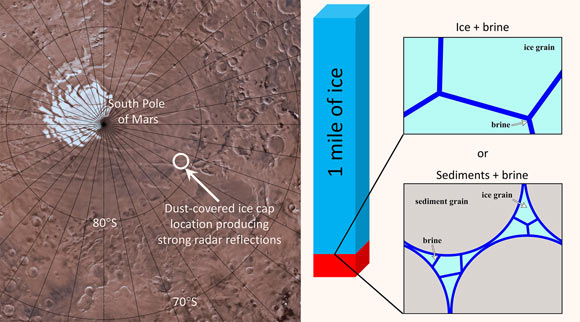In 2018, the Mars Advanced Radar for Subsurface and Ionosphere Sounding (MARSIS) instrument onboard ESA’s Mars Express orbiter found evidence of liquid water under the ice in Ultimi Scopuli, a region near the south pole of Mars. In new research, a team of researchers from Italy, the United States and Australia measured the properties of ice-brine mixtures as cold as minus 98 degrees Celsius (minus 145 degrees Fahrenheit) to help confirm that salty water likely exists between grains of ice or sediment in Ultimi Scopuli.

Mattei et al. studied the antifreeze properties of exotic salts that exist on Mars. Image credit: NASA / JPL-Caltech / USGS / SwRI.
With a 40-m (130-foot) antenna, MARSIS flies over the Red Planet, bouncing radio waves over a selected area and then receiving and analyzing the echoes or reflections.
Any near-surface liquid water should send a strong bright signal, whereas the radar signal for ice and rock would be much smaller.
Because conventional models assume the south polar cap of Mars experiences temperatures much lower than the melting point of water, planetary scientists have questioned the presence of liquid water.
Clay, hydrated salts and saline ices have been proposed as potential explanations for the source of the bright basal reflections.
In the new study, Dr. David Stillman from the Department of Space Studies at the Southwest Research Institute and colleagues used previously published data, simulations and new lab measurements.
“Lakes of liquid water actually exist beneath glaciers in Arctic and Antarctic regions, so we have Earth analogs for finding liquid water below ice,” Dr. Stillman said.
“The exotic salts that we know exist on Mars have amazing ‘antifreeze’ properties allowing brines to remain liquid down to minus 75 degrees Celsius (minus 103 degrees Fahrenheit).”
“We studied these salts in our lab to understand how they would respond to radar.”
The researchers measured the properties of perchlorate brines in an environmental chamber that produces near-liquid-nitrogen temperatures at Mars-like pressures.
“The research showed that we don’t have to have lakes of perchlorate and chloride brines, but that these brines could exist between the grains of ice or sediments and are enough to exhibit a strong dielectric response,” Dr. Stillman said.
“This is similar to how seawater saturates grains of sand at the shoreline or how flavoring permeates a slushie, but at minus 75 degrees Celsius below a mile of ice near the south pole of Mars.”
The search for water in the cosmos is rooted in searching for potential habitability, because all known life requires water.
“In this case ‘following the water’ has led us to place so cold that life as we know it couldn’t flourish,” Dr. Stillman said.
“But it’s still interesting, and who knows what evolutionary paths extraterrestrial life may have taken?”
A paper on the findigns was published in the journal Earth and Planetary Science Letters.
_____
Elisabetta Mattei et al. 2022. Assessing the role of clay and salts on the origin of MARSIS basal bright reflections. Earth and Planetary Science Letters 579: 117370; doi: 10.1016/j.epsl.2022.117370







